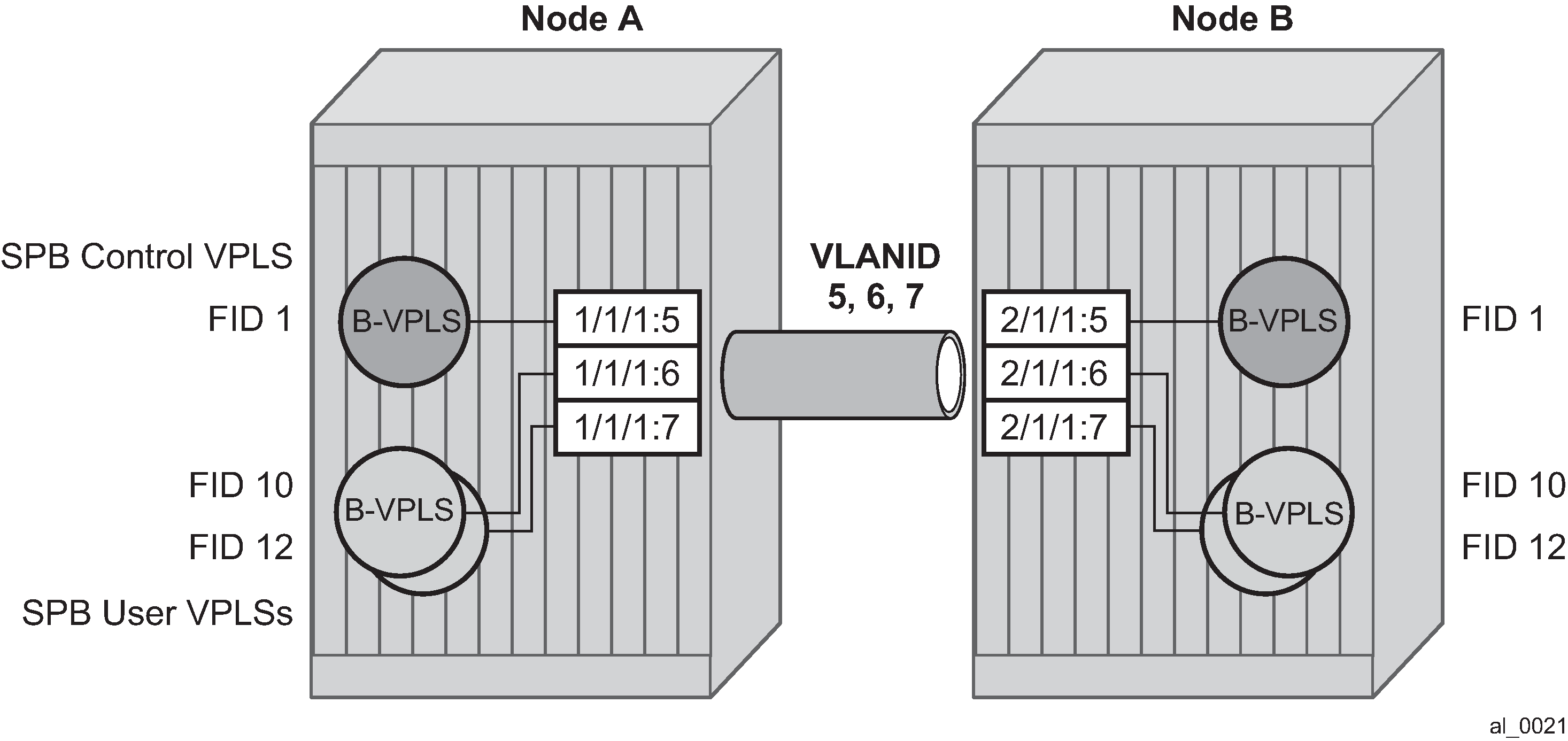Control B-VPLS are required for the configuration of the SPB parameters and as a service to enable SPB. Control B-VPLS therefore must be configured everywhere SPB forwarding is expected to be active even if there are no terminating services. SPB uses the logical instance and a Forwarding ID (FID) to identify SPB locally on the node. The FID is used in place of the SPB VLAN identifier (Base VID) in IS-IS LSPs enabling a reference to exchange SPB topology and addresses. More specifically, SPB advertises B-MACs and I-SIDs in a B-VLAN context. Because the service model in SR OS separates the VLAN Tag used on the port for encapsulation from the VLAN ID used in SPB the SPB VLAN is a logical concept and is represented by configuring a FID. B-VPLS SAPs use VLAN Tags (SAPs with Ethernet encapsulation) that are independent of the FID value. The encapsulation is local to the link in SR/ESS so the SAP encapsulation has been configured the same between neighboring switches. The FID for a specified instance of SPB between two neighbor switches must be the same. The independence of VID encapsulation is inherent to SR OS PBB B-VPLS. This also allows spoke-SDP bindings to be used between neighboring SPB instances without any VID tags. The one exception is mesh SDPs are not supported but arbitrary mesh topologies are supported by SR OS SPB.
Figure: Control and user B-VPLS with FIDs shows two switches where an SPB control B-VPLS configured with FID 1 and uses a SAP with 1/1/1:5 therefore using a VLAN Tag 5 on the link. The SAP 1/1/1:1 could also have been be used but in SR OS the VID does not have to equal FID. Alternatively an MPLS PW (spoke-SDP binding) could be for some interfaces in place of the SAP. Figure: Control and user B-VPLS with FIDs shows a control VPLS and two user B-VPLS. The User B-VPLS must share the same topology and are required to have interfaces on SAPs/Spoke SDPs on the same links or LAG groups as the B-VPLS. To allow services on different B-VPLS to use a path when there are multiple paths a different ECT algorithm can be configured on a B-VPLS instance. In this case, the user B-VPLS still fate shared the same topology but they may use different paths for data traffic; see Shortest path and single tree.

Each user BVPLS offers the same service capability as a control B-VPLS and are configured to ‟follow” or fate share with a control B-VPLS. User B-VPLS must be configured as active on the whole topology where control B-VPLS is configured and active. If there is a mismatch between the topology of a user B-VPLS and the control B-VPLS, only the user B-VPLS links and nodes that are in common with the control B-VPLS function. The services on any B-VPLS are independent of a particular user B-VPLS so a misconfiguration of one of the user B-VPLS does not affect other B-VPLS. For example if a SAP or spoke-SDP is missing in the user B-VPLS any traffic from that user B-VPLS that would use that interface, is missing forwarding information and traffic is dropped only for that B-VPLS. The computation of paths is based only on the control B-VPLS topology.
User B-VPLS instances supporting only unicast services (PBB-Epipes) may share the FID with the other B-VPLS (control or user). This is a configuration short cut that reduces the LSP advertisement size for B-VPLS services but results in the same separation for forwarding between the B-VPLS services. In the case of PBB-Epipes only B-MACs are advertised per FID but B-MACs are populated per B-VPLS in the FDB. If I-VPLS services are to be supported on a B-VPLS that B-VPLS must have an independent FID.